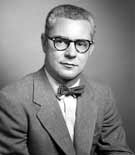|
|
|
|
|
|
|
||||||||||||||||||||||||||||||||||||
 |
|
Jack Morton
|
On the other hand, Bell didn't want to put a stop to scientists following their own leads either, since that had often resulted in interesting inventions. So just after the invention of the transistor had been announced to the public, Mervin Kelly, then the research director of Bell, divided what had been the solid state group into two new groups.
One would continue under Shockley as it always had, studying properties of materials. The other would operate under engineer Jack Morton and concentrate solely on how to improve transistors.
Soon, various organizations began to request transistors -- most notably the military, which wanted to replace the bulky transistors in walkie-talkies with smaller electronics -- so the Morton group quickly began to turn out as many as they could. Starting a production line, after all, was one way of figuring out how to get the kinks out of the process.
But down the hall, it turned out to be Shockley's group which finally devised a transistor that was suited to mass production.
Copyright 1999, ScienCentral, Inc, and The American Institute of Physics. No portion of this web site may be reproduced without written permission. All Rights Reserved.